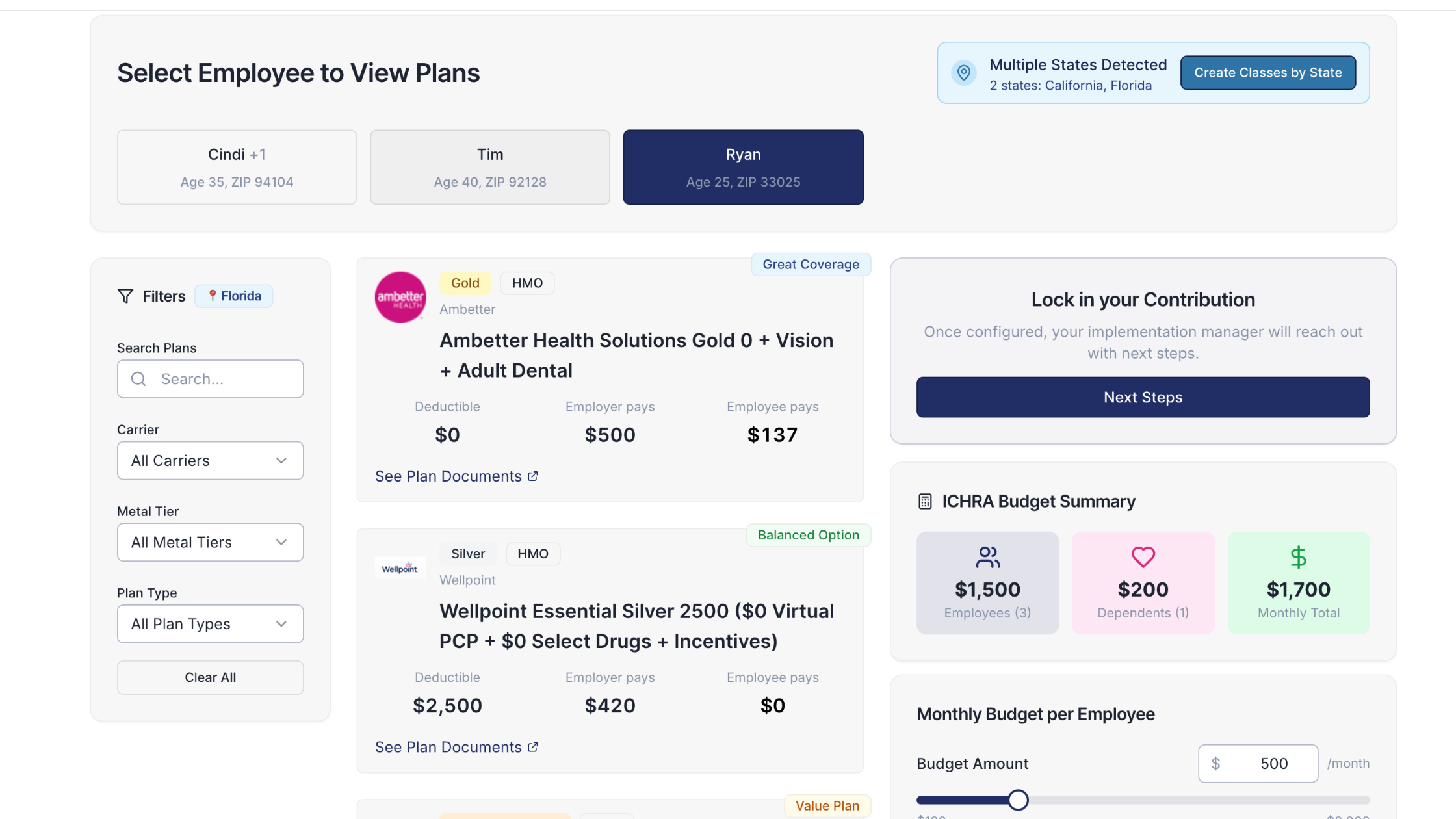Implementing ICHRA in Hospitals and Health Systems: The 3C Framework
%20eligibility%20FAQs.avif)
About the author: Barry Carlson is a distinguished health insurance industry leader with over 30 years of experience. Specializing in employee benefits and large employer self-funded spaces, Barry has an impressive track record in sales leadership and business development.
As an advisor to Venteur, Barry leverages his extensive knowledge in health insurance, focusing on innovative solutions like Individual Coverage Health Reimbursement Arrangements (ICHRA).
In my three decades working in the health insurance sector, I've closely observed and navigated substantial shifts in healthcare.
Particularly for hospitals and health systems, the evolution has been profound, driven by advancements in technology, regulatory changes, and new patient care models. These shifts have not only transformed how healthcare services are delivered and managed but also how these institutions, as major employers, approach employee benefits.
Amidst this evolution, innovative approaches like the Individual Coverage Health Reimbursement Arrangement (ICHRAs) have emerged as key strategies for managing employee health benefits.
As a CFO or key decision-maker in a hospital system, understanding the suitability of an ICHRA plan for your organization is crucial. And over countless conversations, I created a system of principles called the 3 C Framework – Cost, Concept, and Contribution – a ‘decision tree’ helping operators determine whether ICHRA is right for them.
In the following sections, you'll get an in-depth look at the 3 C Framework, along with practical questions to steer you towards the right decision. I'll also present a few scenarios to illustrate the potential cost savings for hospital systems that switch to ICHRAs – savings that could be in the millions of dollars.
Overview of the 3C Framework
In the ever-shifting landscape of healthcare finance, hospitals and health systems are facing a mounting challenge: managing the escalating costs of providing health benefits to their employees.
Recent trends paint a stark picture – healthcare costs have been oscillating in the last 5 years, with a notable spike in 2021 and a projected continual rise in the near-future.
As of 2023, employers are shouldering a significant portion of these costs, contributing an average of $12,562 per employee. This figure is set to grow, with the total health benefit cost per employee expected to increase by 5.4% in 2024, outpacing the average annual increases of the past decade.
This scenario places a heavy burden on hospital systems, where the workforce is not only large but also deeply knowledgeable about healthcare. The resulting and unique position of hospitals, as both providers and employers, intensifies the need for strategic financial planning.
As new, expensive therapies emerge and factors like high inflation and labor shortages in healthcare add to the cost pressures, health systems around the country are seeking sustainable ways to balance these expenses.
Amidst this backdrop, my '3 C Framework' – Cost, Concept, and Contribution – offers a guiding light.
Developed through years of experience and observations, I designed this framework to help hospital CFOs and administrators manage rising costs while navigating the complex decisioning needed to create high-quality healthcare benefits for their employees.
The '3 C Framework' comprises what I consider are three critical decision trees:
- Cost: A thorough analysis of the financial implications of switching to an ICHRA plan, helping leaders assess potential savings and weigh them against current healthcare expenditures.
- Concept: The cultural and operational shift towards a consumer-driven healthcare model, emphasizing the importance of choice and personalization in health insurance, and aligning the benefits strategy with modern consumer expectations.
- Contribution: The final component deals with creating a fair and equitable structure for employee contributions towards their health plans, ensuring that benefits are distributed in a manner that is sensitive to the diverse needs of a workforce.
For anyone responsible for managing finance and expenses in their healthcare system, the '3 C Framework' offers a structured and strategic approach to navigating the complex world of health benefits. It not only simplifies the decision-making process but also ensures that the chosen strategy is financially sound, culturally aligned, and equitable for all employees.
Let me take you through each step and questions on how you can consider them for ICHRAs:
1. Cost: Assessing unique financial implications for hospitals
The first step is to analyze the cost. Pretty matter of fact on the surface – but it goes deeper than just crunching numbers.
As a CFO, consider the volatile trend in healthcare costs. In 2021, we saw an 8.2% increase, dropping to 4.6% in 2022, but still slightly below the projected 5%. Now, projections for 2023 and 2024 indicate a 6% increase in post-plan design changes.
These aren't just statistics; they're indicators of a trend that could significantly impact your businesses’ financial health.
I've seen firsthand how hospital systems, especially those that are self-insured, face a unique set of financial dynamics when it comes to healthcare benefits. There's an intricate balance to maintain, and understanding it is key to making informed decisions.
Many hospitals operate under a self-insured model, which creates an interesting scenario in terms of healthcare spending. In this setup, a significant portion of the healthcare expenditure doesn't really leave the system; it's circulated internally.
Hospital employees typically use their benefits within their own healthcare system, leading to a high volume of domestic claims. This means that the money spent on health benefits often ends up paying for services provided by the hospital itself. It's a cycle of spending and reimbursement that exists within the walls of the hospital.
Now, this internal circulation of funds brings us to an important consideration – the analysis of domestic versus external claims. For a hospital, understanding this ratio is crucial. If a hospital finds that less than half of its claims are internal, there lies a golden opportunity with ICHRA plans. Shifting to an ICHRA can open up pathways to significant cost savings.
But there's more to it. Hospitals might not just save on premiums; they could potentially increase their internal claim spend. This scenario, which I like to refer to as the 'double savings' opportunity (more on this in section 4), is where hospitals can truly optimize their financial health.
By reducing premium costs and simultaneously boosting the funds flowing back through internal services, hospitals can turn their healthcare benefits plan from a mere cost center into a strategic financial asset. It's about understanding and leveraging the unique position hospitals hold in the healthcare ecosystem.
Here’s how.
Applying a Premium to Reimbursement Matrix in the Cost Decision Tree
To really drive home the point, let’s look at a simple 4x4 matrix of how hospitals should think about Premiums and Reimbursements to help determine if ICHRA can help them save millions:

When considering a shift to ICHRA or any other healthcare benefits strategy, here's how you should use the matrix:
- Plot your current position: Determine which quadrant your hospital currently resides in based on your Premium costs and Reimbursement rates.
- Assess the impact of change: Evaluate how transitioning to an ICHRA would shift your position within the matrix.
- Consider the broader picture: Factor in the demographics of your workforce, union agreements, and the overall financial health of your system (more on that in the next sections).
Here’s how you should model your thinking around costs to determine if you qualify for the concept and contributions steps:
- Analyze internal spend: If a significant portion of your spend is internal (employees using your hospital's services), shifting to an ICHRA might not offer substantial savings.
- Weigh external claims: Conversely, if your system has a higher proportion of external claims, transitioning to ICHRA could offer substantial benefits.
- The double win potential: Some hospitals might find themselves in the advantageous position of both lowering premiums and increasing internal reimbursements – a real game-changer.
Since cost is arguably the most important aspect of the 3 C Framework, here’s a few questions I field to folks discussing potential healthcare costs savings:
- How does your current healthcare spending per employee compare to the potential costs under an ICHRA plan?
- What are the projected long-term financial impacts and savings of switching to an ICHRA plan?
- How might adopting an ICHRA plan affect the overall budget and financial health of your hospital system?
- Are there cost-effective alternatives that can match or exceed the benefits of an ICHRA plan?
- How will the predicted increase in healthcare costs in the coming years impact your current health benefits strategy versus an ICHRA plan?
- How does your internal versus external healthcare spend ratio look?
- Could transitioning to ICHRA potentially lead to double savings for your system?
By understanding your position within this cost decision tree, you can make more informed decisions, ensuring that your healthcare benefits strategy is not only financially viable but also aligned with the needs of your diverse workforce.
It's not just about reducing premiums – it's about maximizing overall financial efficiency.
However, let me stress this point: If costs outweigh benefits, there’s no point in moving on from here. With that said, in the healthcare benefits matrix, some hospitals may discover they're positioned to achieve what I call the "Double Win," occurring when a hospital system can simultaneously lower its premium costs while increasing reimbursements for the services it provides. This is a huge potential benefit for the financial health of a hospital, and I expand on this in Section 4.
From here, if ICHRA is looking good for your balance sheet, we’ll move on to the concept decision tree.
2. Concept: Adapting to health care workers - a diverse and knowledgeable workforce
The concept stage involves embracing the idea of consumerism in healthcare. ICHRA allows employees to choose health plans that best suit their individual needs, moving away from the one-size-fits-all approach.
That said, this shift can be a significant cultural change for any organization, especially in the healthcare sector where traditional models have long been the norm.
When it comes to concept, hospitals face a unique challenge due to their workforce diversity:
- Diverse health requirements: Hospitals employ a wide array of professionals, from surgeons to custodial staff, from young workers to older doctors with long histories and large practices, each with different health needs. This diversity demands a more nuanced approach to healthcare benefits.
- Employee education and support: Transitioning to ICHRA means not only offering choice but also ensuring that employees are equipped to make informed decisions. This is where educational tools and resources become essential.
Implementing ICHRA means empowering employees with choice – a fundamental aspect of American consumer culture. It's about bringing the same level of personalization and autonomy that people expect in other areas of their lives into their healthcare decisions.
Your hospital or health system must be comfortable with this paradigm shift and recognize the value it brings to its employees.
Since the ‘concept’ of a marketplace plan is entirely new for individuals, it's important to review and answer the following questions in the POV of your employees:
- How well does the concept of ICHRA align with our organizational values and culture, particularly regarding employee autonomy and choice?
- Are our employees ready and equipped to make informed choices in a consumer-driven healthcare model that ICHRA promotes?
- How will the shift to an ICHRA plan impact employee satisfaction and perception of their benefits?
- Does the ICHRA model align with our goals for employee health outcomes and overall wellness?
- How might the adoption of an ICHRA plan enhance or hinder our reputation as an employer in the healthcare industry?
- How can we support our diverse workforce in understanding and making the most of ICHRA benefits?
- What educational strategies can we implement to ease this transition?
3. Contribution: Developing a fair structure
The final C is contribution, which involves creating a fair and balanced contribution structure for employees.
In a traditional group insurance plan, all employees might pay the same rate for coverage. However, with ICHRA, the costs are individualized. And things get a bit more complex for hospitals in particular:
- Equitable contribution strategies: Hospitals need to devise contribution plans that cater to the diverse healthcare needs of their workforce. This includes considering age-related factors, especially for older employees like the doctors who never want to stop working but face higher personal healthcare costs.
- Unionized staff considerations: Many hospital systems have unionized employees with specific negotiated benefit levels. Aligning ICHRA contributions with these negotiated levels is a delicate balance.
A well-structured ICHRA plan should balance the individual insurance market's nature with the organization's need to provide fair benefits to all employees.
For example, a hospital might decide to contribute more towards the premiums of older employees, who typically face higher healthcare costs, to ensure equity across its workforce.
It's crucial to develop a contribution strategy that is equitable and doesn’t disproportionately impact certain groups of employees. Here’s a few important items to consider before determining your company’s overall contributions:
- How can we structure our contributions in an ICHRA plan to ensure fairness and equity among employees of diverse ages and health statuses?
- What would be an appropriate and sustainable contribution strategy that aligns with our financial objectives and employee needs?
- How does the contribution structure under an ICHRA plan compare to our current group health insurance plan in terms of employee affordability and value?
- Are there creative ways to structure contributions that could enhance employee engagement and appreciation of their health benefits?
- How will changes in contribution structure under an ICHRA plan impact our ability to attract and retain top talent in the healthcare sector?
- How can we structure our ICHRA contributions to be fair and equitable across different employee demographics?
- What strategies can we employ to align ICHRA contributions with existing union-negotiated benefit levels?
4. The “Double Win” - Cost savings scenarios for hospitals
Though ICHRA might not work for your health system, for a select few there’s a massive benefit in what I like to call the "Double Win" scenario.
The “Double Win” Hospital Scenario
Imagine a hospital system called 'Metro Health Services' that caters to a large employee base of 1,000 staff members. They spend about $2,000 monthly per employee on health plans, which totals a staggering $2 million each month.
Metro Health transitions to an ICHRA plan, and by doing so, they manage to conservatively cut costs by 20%, reducing their monthly expenditure to $1.6 million. Annually, this translates into a savings of $4.8 million.
These savings are substantial, but the real magic of the "Double Win" lies in how these funds are reallocated. Metro Health could channel these resources into enhancing patient care facilities, investing in groundbreaking medical technologies, or upskilling their workforce through comprehensive training programs.
Alongside the cost savings from lower premiums, they could also refine their internal policies to encourage employees to use the hospital's own services. This policy shift increases internal fund circulation, as the money spent on premiums flows back into the hospital through employee utilization of its services.
From there, Metro Health not only reduces its annual health insurance expenses but also boosts its internal service reimbursements, turning the health benefit plan into a revenue-generating mechanism. A strategy like this can transform financial projections and operational sustainability for healthcare systems.
Final thoughts
As I reflect on my journey in the health insurance industry, the '3 C Framework' of Cost, Concept, and Contribution stands out as a pivotal guide for hospitals and health systems evaluating ICHRA plans. This framework isn't just about the numbers; it's about aligning your organization's financial objectives with its core values and culture.
The financial advantages of ICHRAs are clear, particularly in the potential for significant cost savings. But beyond the balance sheet, ICHRAs offer something equally valuable: the empowerment of your employees. This approach gives them more control and choice in their healthcare, fostering a sense of ownership and satisfaction.
In my experience, the shift to ICHRA is more than just a financial decision; it's a strategic move towards a more sustainable, employee-centric healthcare model.
It’s time for healthcare organizations to seriously consider this change. It's not just about fiscal prudence; it's about building a system that truly supports and values the people at its heart – your employees.
You got questions, we got answers!
We're here to help you make informed decisions on health insurance for you and your family. Check out our FAQs or contact us if you have any additional questions.
Explore more related content
What is Venteur
Explore the best human-first Health Insurance platform
Simple, personalized health benefits
Sign up in minutes, define your contribution, and let your employees choose the health plan that works right for them
Integrations to make everything run smoothly
We'll connect with your payroll and finance systems to make deductions and premium payments seamless
Easy onboarding and off-boarding
In just a few clicks, add your roster and make updates on the fly. We'll handle it from there.
Venteur Certified Brokers to help your employees pick the right plan
Our trusted brokers ensure the best outcomes for employees and employers by unlocking health savings and providing unrivaled plan options.
AI-powered plan recommendations to give you confidence while you shop
Backed by 30 years of healthcare data, Venteur’s AI helps employees compare and choose the best plan for their unique situation.
Compliance and reporting because no-duh!
Venteur manages plan administration, reporting, and compliance so you can focus on growing your business.


